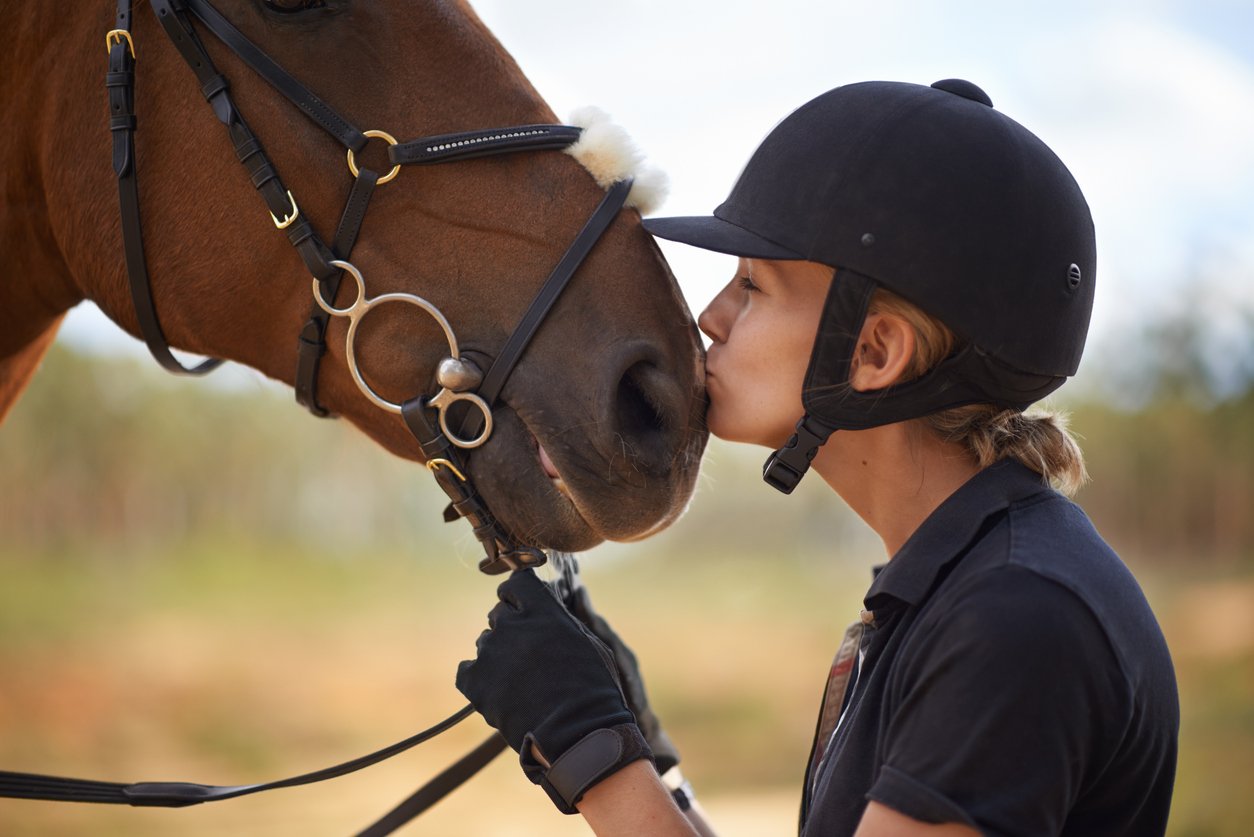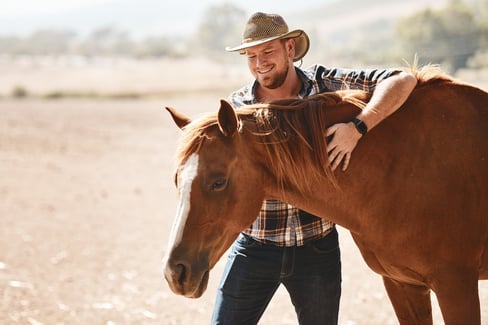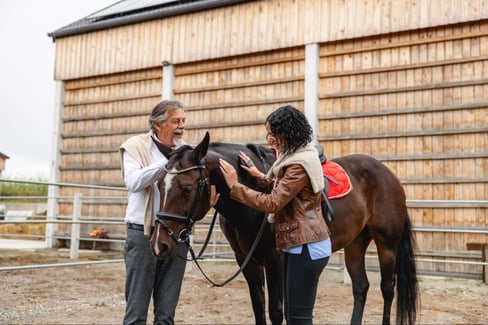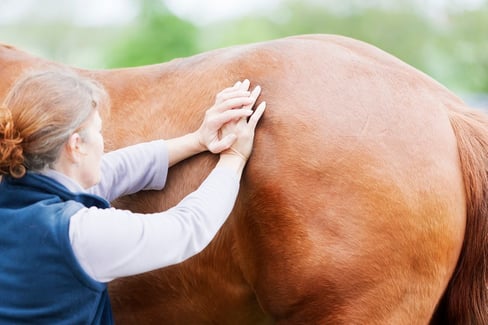Table of Contents
Whether you train world-class eventers or keep a few old schoolmasters to ride in your spare time, the health and wellbeing of your equine friends are your top priority.
Regardless of your experience, there is a lot to know about horse health. Googling symptoms and searching for advice online can be overwhelming!
Taking care of such large yet delicate animals is a huge responsibility. Horse health care demands more than just a good diet and regular exercise – taking care of their muscles and joints is also important! Great care must be taken to avoid potentially costly and painful problems.
To help any horse owner looking for a wealth of information on horse health, we’ve put together a guide to common horse health issues in both domestic and sport horses.
We’re here to help you learn to recognize and treat these issues, but also how to prevent them.
Let’s get started.
Common Horse Health Issues: Domestic Horses
They might not compete in show-jumping or racing, but that doesn’t mean that domestic horses aren’t prone to health concerns. Years of schooling, playing with their friends in the pasture, and dietary sensitivity can lead to several health problems in domestic horses.
We’ll be discussing three main issues affecting domestic horse health:
- Locked Stifle Joints
- Laminitis
- Arthritis
All of these problems can be very painful conditions for your horse, with complex treatment requirements.
1. Locked Stifle Joints
It’s common for humans to get sore knees, particularly if we’re getting older or doing too much weight-bearing exercise.
Now think about our equine friends, who often have to carry heavy loads on their back while undertaking challenging or fast-paced tasks such as:
- Weaving between barrels
- Jumping
- Circle work
- Hacking up steep hills
The horse’s stifle does the same job as the human knee. It acts like a hinge, helping your horse to balance when standing – especially when sleeping, otherwise, they would fall over!
In scenarios like the above, your horse’s stifle is supposed to lock in place. The ligament in the knee hooks over the ridge on the femur bone.
When the horse wants to move again, it’s usually effortless for them to unlock their stifle to engage movement.
But, some horses develop stiffness and discomfort in their stifle joint which delays this ‘unlocking movement’. This can lead to mild and severe problems if left untreated.
Symptoms of a Locked Stifle Joint
- Minor lameness
- Hesitancy or delayed movement (especially if they’ve stood still for a long time)
- Stumbling on downhill slopes
- Problems cantering or changing leading legs
- Discomfort or unwillingness to do circle work
Please consult an equine veterinarian if you notice your horse kicking out and having problems walking. They can properly evaluate the severity of the situation, and offer the best treatment options for you.
Treatment typically involves a gradual progression of exercises that helps the horse regain proper gait and mobility of the knee joint.
These exercises start with no rider and then graduate to involving a rider that takes the horse both downhill and uphill. Fortunately, 71% of horses are usually able to return to their normal activities with proper treatment.
Prevention of a Locked Stifle Joint
Locked stifle joints are common for:
- Ponies
- Foals
- Unfit horses
Many experts believe that rapid growth spurts can lead to locked stifle joints. However, preventable conditions such as obesity, improper nutrition, and neglected fitness are also possible causes of locked stifle joints.
These can make it difficult for your horse to regain mobility and walk properly and comfortably. So these conditions must be addressed within the scope of treatment.
To that end, proper nutrition, including a high-quality joint supplement, can help with preventing this problem and reducing symptoms for your horse.
2. Laminitis
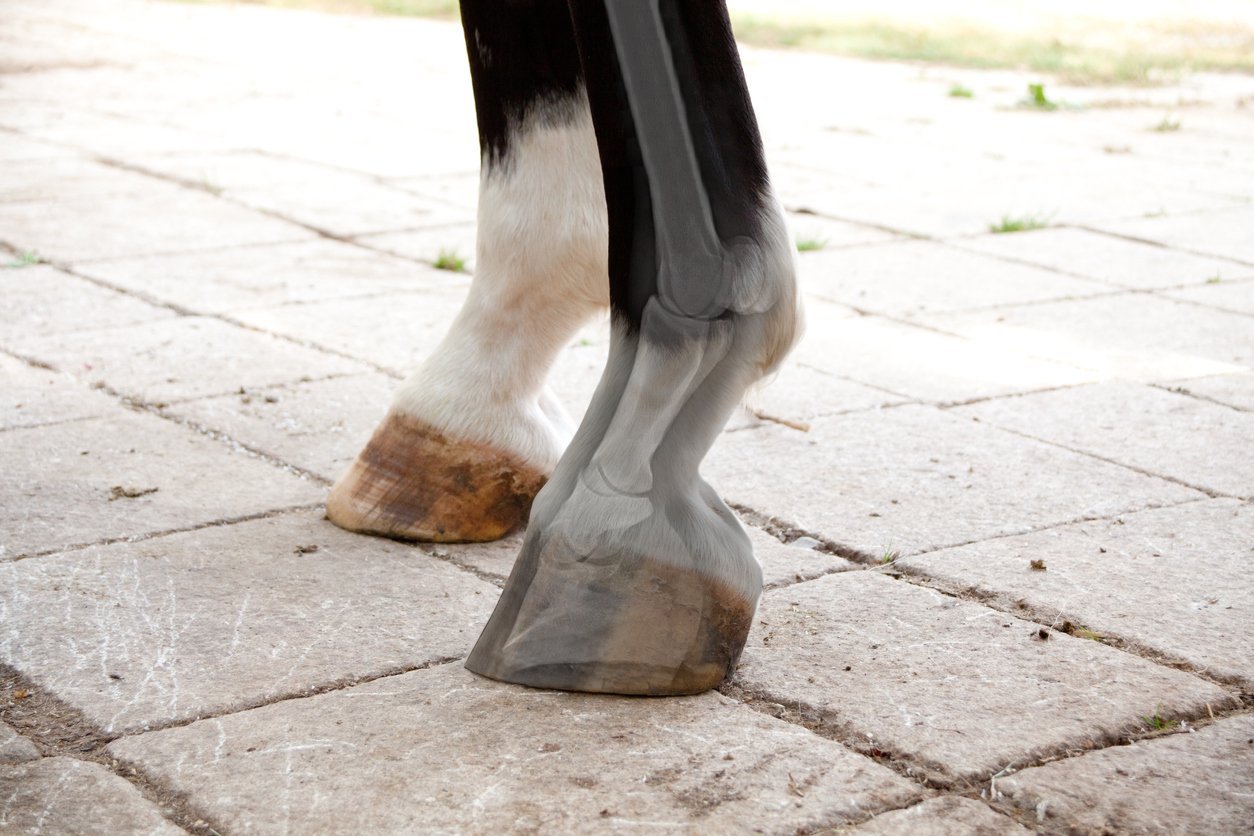
It’s one of the most painful conditions our beloved horses can experience – and it’s devastating for owners to deal with. Laminitis is a very serious horse health condition that causes problems with the pedal bones.
Left unchecked, laminitis can become so severe that the pedal bone penetrates the soft tissue of your horse’s foot!
It’s important, therefore, that strict care is taken, and that you keep an eye on your horse’s gait and posture to ensure ligament and tendon health.
1 in 10 horses develops an episode of Laminitis every year.
Symptoms of Laminitis
Should you notice any kind of difficulty walking, contact your equine veterinarian immediately. Laminitis can quickly escalate, and cause problems so severe that the only course of action advisable is euthanasia — not something you would want to consider!
Experts aren’t 100% sure why Laminitis occurs at all, but it usually occurs when a case of inflammation develops in another part of the horse’s body – such as colic or diarrhea for example.
Shortly thereafter, the tissues that bond the hoof wall (Laminae) to the pedal bone become inflamed.
Other causes and risk factors of Laminitis include:
- Heat in the feet
- Hesitant gait
- Cushing’s disease in older horses
- Horses that are overweight
- Severe colic
- Other foot diseases
Because of this inflammation, the pedal bone can sink or rotate within the hoof. The weight of the horse, as well as any rider or equipment, can exacerbate this. As one can imagine, this can become a very painful condition for the horse.
Prevention of Laminitis
Depending on the cause, you may not always be able to prevent Laminitis. However, some tips can help with the prevention, or at least lessen the severity of onset.
- Keep The Feet Cool. Laminitis often occurs as a result of some other sort of inflammation in the body. Should inflammation or a condition develop in another part of the body, pay very close attention to the feet. Use cooling methods like cool water on the feet to help prevent inflammation.
- Watch Their Weight. It’s very important to ensure proper diet and adequate, regular exercise. An overweight horse is prone to many conditions, Laminitis being one of them. Keeping your horse at a healthy weight helps reduce the chance of Laminitis developing.
- Consult Your Vet. Should your horse develop symptoms of Laminitis, consult your equine veterinarian immediately! After a thorough exam, they can prescribe medications and even supplements that can help prevent worsening of the inflammation of the laminae.
3. Arthritis
Also referred to as Osteoarthritis, this condition is usually associated with older horses – typically over 15 years old. However, it can also affect younger animals should they develop other horse health conditions and infections. Arthritis can develop regardless of your horse’s activity level.
Arthritis refers to inflammation of the joints resulting in pain and stiffness. This inflammation can be caused by injury or infection, which damages the bone surface. The friction between these damaged surfaces then causes inflammation, and in turn causes your horse great discomfort.
This is a degenerative condition that can be chronic, and at some point, it’s mainly a matter of keeping your horse as comfortable as possible. Also, you can introduce a supplement to help slow down the inflammation and improve your horse’s mobility and comfort.
Symptoms of Arthritis
If your horse is affected, you’ll notice symptoms such as:
- Morning stiffness around affected joints that lasts about an hour
- Pain, swelling, or stiffness of the joints
- Stiffness and/or pain that gets worse with inactivity
- Reduced range of motion
Acute arthritis is slightly different, and it’s usually caused by infection or injury. If the acute condition isn’t healed properly or doesn’t respond favourably to treatment, it can lead to chronic arthritis. This happens when the bone surfaces don’t heal properly and aren’t properly cushioned with the soft tissue.
During an exam, a qualified equine veterinarian can determine how serious your horse’s case of arthritis is, as well as the level of pain, and advise you as to what steps to take next.
Prevention of Arthritis
While there is little one can do that can completely prevent arthritis in older horses, you can take steps to reduce the risk, delay the onset of arthritis, as well as make things more comfortable as they get older.
Steps you can take to help reduce the risk and delay onset are:
- Feed a balanced diet
- Avoid forced exercise of overexertion (especially before they attain physical maturity
- Have a good routine with your farrier
- As the horse gets older, pay very close attention to your horse for even the slightest inkling of problems
- Start treatment for arthritis as early as possible
- Provide supplements that promote healthy joints
Making sure to exercise your horse properly by giving them enough time to warm up and down before and after a ride.
Common Horse Health Issues: Sports Horses
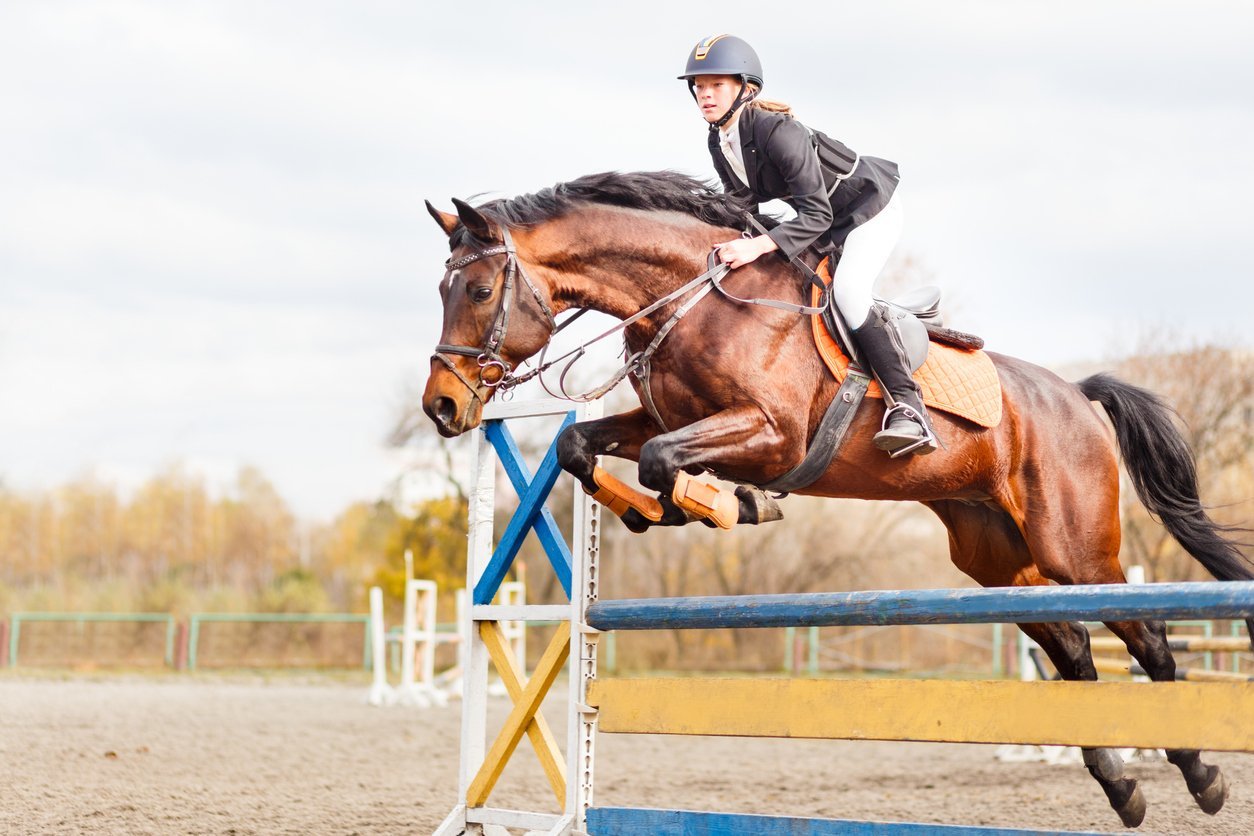
The equine sporting world is fast-paced and competitive. It places huge demands on your horse’s body, so great care must be taken to treat and prevent sport horse health problems.
There are a few major horse health concerns that are unique to certain sports – from endurance to racing to dressage. To make sure your champion maintains optimum performance, it’s important to pay close attention to his mood, movement, flexibility, and overall happiness daily.
It’s important to know how to solve, or even better, prevent injuries to your sports horse.
We’ll be looking at three horse health conditions that are more common to sports horses since many actions performed are repetitive. Because of this, a strain is placed on muscles, joints, tendons, and ligaments on a more sustained basis than that of a domestic horse.
1. Desmitis
With so much emphasis put on the joints and ligaments with running and jumping with a rider, there’s no wonder that problems can occur. One of such problems is Desmitis. This is one of the most common causes of lameness in sports horses.
There are three main types of Desmitis:
- Degenerative Suspensory Desmitis (DSD)
- Proximal Suspensory Desmitis (PSD)
- Degenerative Suspensory Ligament Desmitis (DSLD)
All of these terms refer to inflammation of the ligaments and can cause varying degrees of lameness. Strict care must be taken to not exacerbate the problem. This can prove difficult at times because the problem isn’t always apparent until it has become severe.
Symptoms of Desmitis
- Swelling
- Poor performance
- Hesitating to stand or perform other movements
- Heat at the affected area
- Limping or inability to sustain weight on the affected limb
There are some cases where horses show no symptoms, very mild ones, or their symptoms can be mistaken for other conditions.
Desmitis usually presents itself as lameness more clearly if only one leg is involved. If both legs are affected, the horse’s gait will change.
With adequate rest, 90% of Proximal Suspensory Desmitis cases in the front limbs can heal. Treatment can be lengthy, however, and it can take several months, or even a year before a horse completely recovers from this condition.
Prevention of Desmitis
Preventative care is done by making sure that your horse doesn’t over-exert his precious ligaments. In terms of competitions that involve jumps of 6-7 feet, it’s important to not practice these jumps daily. This can cause unnecessary and premature wear and tear on the tendons. Instead, practice with 3-4ft jumps maximum.
Get regular check-ups by your veterinarian, and discuss your training routine to ensure that your horse’s ligaments are in good condition.
Your equine vet may also recommend a course of supplements that help keep your horse’s soft tissues – such as ligaments and tendons, in good health. Consult your equine vet for more information on safe options.
2. Tendon Injuries
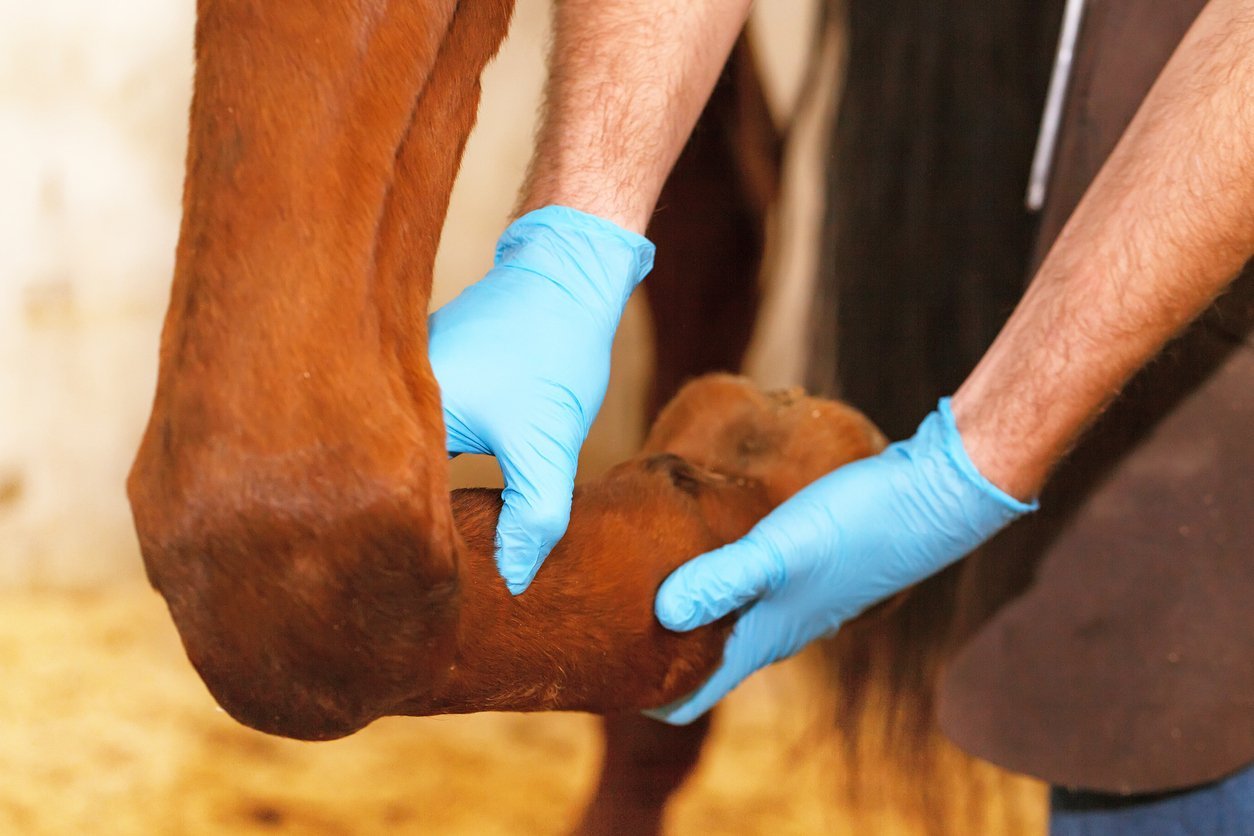
This is another type of injury common to sports horses because of the overexertion of tendons. Just like ligaments, tendons receive some of the most impacts from jumping and riding. Most tendon injuries occur during vigorous exercise.
Tendons attach your horse’s muscles to his bones and enable him to move. Tendons are very elastic but, with excessive strain or trauma from competitive sports, they can be torn.
Symptoms of Tendon Injuries
There is a wide range of injuries that can occur with your sport horse’s tendons. It could be a minor inflammation with no lameness, or a tear or rupture of the tendon, requiring surgery – and possibly ending the horse’s sports career.
Things that can cause tendon injuries are:
- Strenuous exercise
- Over-stretching of the tendons
- Working on un-level ground
- High-speed jumps
If you observe your horse walking with their toes up or any kind of swelling of the legs, it could be an indication that a tendon has torn, and you need to visit an equine vet immediately.
Prevention of Tendon Injuries
Especially when it comes to sports horses, repetitive actions will cause tendons to eventually break down.
You can prevent tendon injuries in your sport horse by:
- Warming him up adequately
- Investing in good shoeing
- Conditioning before attempting harder work
- Keep a keen eye out for even minor signs of injury
Always carefully monitor your horse’s walk, and be sure not to overexert them during training exercises. Horses that compete in high-grade show jumping competitions are more likely to be affected.
3. Back Injuries
Sport horses typically experience more back issues than say, racehorses, as they carry more equipment on their backs. Because of the complexity and large number and size of vertebrae that comprise the horse’s spine, some back problems will inevitably occur.
Symptoms of Back Injuries
Conditions such as ‘Kissing Spine’, which affects 39% of the horse population, can present a major problem for your horse’s career. Kissing Spine is when some of the vertebrae in the spine lie too close together, and rub together, causing the horse a great deal of pain.
There are many causes of back problems such as:
- Lameness in the horse
- Improperly fitted saddles
- Heavy/unbalanced riders
- Developmental issues
Prevention of Back Injuries
Making sure your tack, especially the saddle fits properly is one of the first ways you can prevent serious back injury.
We’ve listed some common treatments for back injuries in sport horses:
| Back Injury Treatment | Definition |
| Mesotherapy | Injections of anti-inflammatories into both sides of the spine to stop muscle spasms. |
| NSAIDs | Non-steroidal anti-inflammatory drugs that can be administered orally or topically. Examples include bute, Banamine, and previcox. |
| Alternative medicine | Chiropractor, acupuncture, massage |
Always make sure riders are positioned properly and evenly balanced on your horse’s back. A poor seat, especially when jumping, can place excessive impact on your horse’s back.
Equine Supplements To Improve Your Horse’s Health
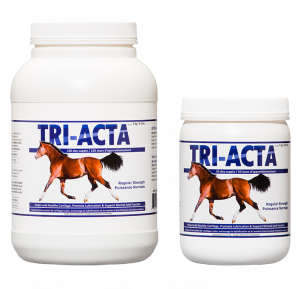
A quality joint supplement, with a high concentration of active ingredients, can significantly reduce your horse’s risk of developing health issues – particularly in their joints, muscles, and tendons.
Introducing a joint supplement to your horse’s diet can both alleviate current symptoms and prevent further injuries, so it’s a great option regardless of your horse’s age, fitness, and career.
When looking for the best supplement for your domestic or sports horse, you should make sure it contains the following ingredients:
| Ingredient | What is it? | Benefits | Found In |
| Glucosamine Sulfate | A natural compound found in animal cartilage. Sulphur is an essential nutrient for joint tissue that produces cartilage. | Helps produce proteoglycans which produce cartilage. | TRI-ACTA & TRI-ACTA H.A. |
| Glucosamine Hydrochloride | A highly potent form of glucosamine that is more stable and therefore more absorbable. | The two types of glucosamine, when used together, promote cartilage production. | TRI-ACTA & TRI-ACTA H.A. |
| MSM | A naturally occurring substance found in animals, humans and plants. | Reduces pain and inflammation in the joints. | TRI-ACTA & TRI-ACTA H.A. |
| Chondroitin | A vital part of cartilage found in animals, humans and plants. | Prevents cartilage from breaking down and deteriorating by inhibiting the destructive enzymes that wear away cartilage. | TRI-ACTA & TRI-ACTA H.A. |
| Hyaluronic Acid | Also known as hyaluronan, it is a clear, gooey substance that is naturally produced by the body. The largest amounts of it are found in skin, connective tissue and eyes. | Retains water to keep tissues well lubricated and moist. It also helps to speed wound healing, relieves joint paint by keeping bones well lubricated and preserves bone strength. | TRI-ACTA H.A. |
TRI-ACTA for Equine
Providing preventative support for younger horses and helping mitigate the early onset of joint degeneration and other mobility issues.
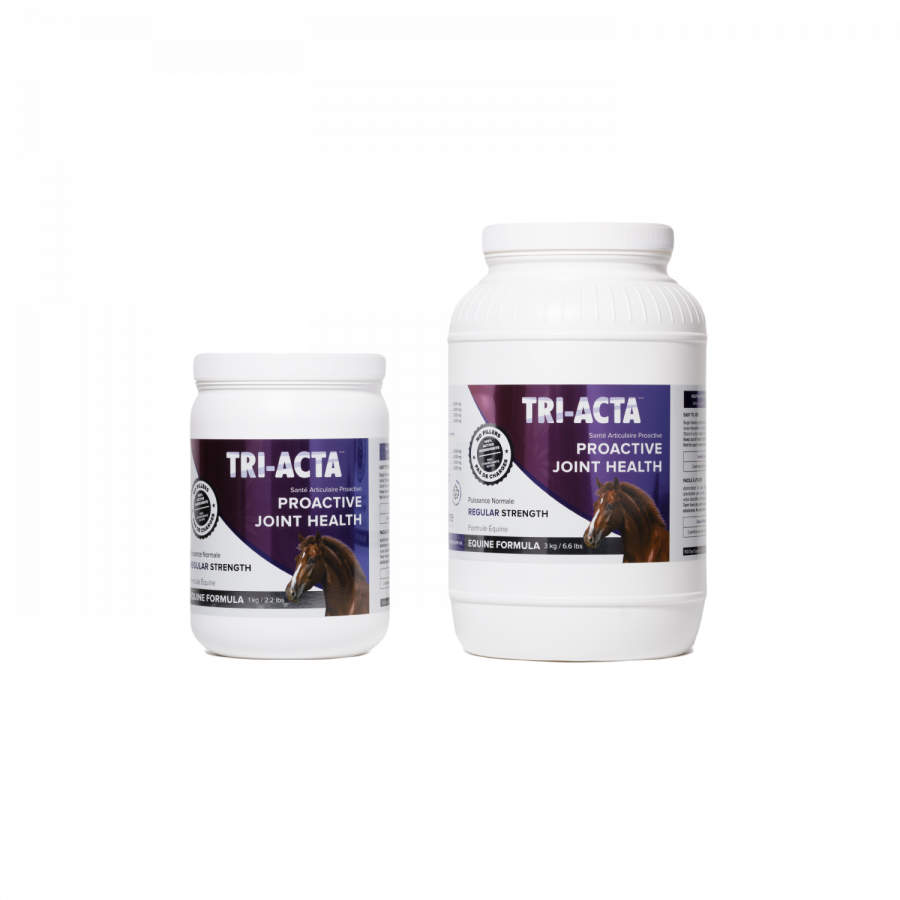
TRI-ACTA for Equine
Providing preventative support for younger horses and helping mitigate the early onset of joint degeneration and other mobility issues.

Common Horse Health FAQ’s
Here are some common questions asked by equine enthusiasts.
What is the normal body temperature for a horse?
About 99 – 108 degrees Fahrenheit. It’s important to keep an eye on your horse’s body temperature as anything higher, or even lower than the average range can indicate illness or infection.
How can I tell if my horse is injured?
Look out for anything that’s out of the ordinary for your horse. Observe them during daily feeding, grooming, and all interactions. Do they appear to be uncomfortable? Hot to the touch? Irritable? You can lead them gently in a circle or lunge them at a walk to see if they are limping or showing signs of discomfort. Always call your vet if you suspect there is something wrong.
How can I keep my arthritic horse comfortable?
Make sure they keep a good, healthy weight. An overweight horse will have more weight on their already inflamed joints and would increase discomfort. In addition, your vet may prescribe NSAIDs to help produce inflammation. Supplements with glucosamine such as TRI-ACTA can also be very helpful with joint pain and slowing cartilage degeneration.
How do I give my horse a new supplement?
When choosing a joint supplement, it is important to know what is in the product. Reading a supplement label can be tricky because there are different formats and dosages often dependent on the weight of the animal. Give your horse the correct supplement dose with his daily feed. If your horse is picky with his food and can tell something’s different, you can start with a small amount and slowly increase the dosage until your horse is comfortable with the change in taste. You can add flavourful ingredients such as molasses, vegetable oil, and garlic to mask the flavour without giving your horse unnecessary extra treats!
Conclusion: How To Start Preventing Horse Health Issues
Learning how to identify, treat, and prevent common horse health problems is essential for any horse owner.
To protect your horse from injuries and common health problems, you can start prevention today by introducing a high-quality supplement to his daily feed.
Integricare is a world-class provider of joint supplements for domestic and sport horses, with products suited to young horses and older horses with ongoing health problems.
Our TRI-ACTA equine supplement is the perfect way to protect your young horse’s mobility and prevent joint degeneration. Composed of 100% active, pharmaceutical-grade ingredients, with absolutely no fillers, TRI-ACTA offers a small yet potent dose to support your horse’s health and wellbeing.
For older horses or competitive sport horses with ongoing joint problems or arthritis, our TRI-ACTA H.A. quickens the healing process and accelerates cartilage formation. This improves mobility in older horses and ensures that their joint tissue is protected from further damage.
At Integricare, we’re dedicated to helping horse owners give their equine companions a long, happy, healthy life. If you have any questions about our products, get in touch with our team today.
Newsletter Signup
Subscribe to our newsletter to receive the latest news and exclusive offers.
.jpg?height=2000&name=Cliick_Integricare-DISPLAY-REVISEDV2%20(1).jpg)
Proactive & Therapeutic Joint Supplements
When given daily, Integricare joint supplements recover bone and joint injuries faster and help prevent mobility injuries from happening in the first place.

